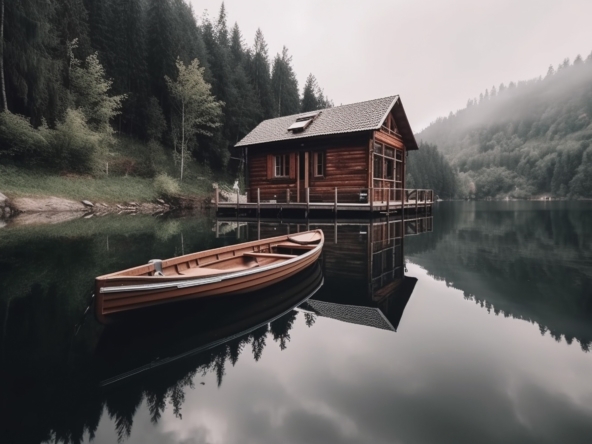Dreaming about waking up to the gentle lull of waves, having a serene view of the setting sun on your horizon, or merely stepping into a backyard that doubles as a personal beach is a vision shared by many of us.
The allure of waterfront living is undeniable, but behind the sparkling waves and picturesque scenes lie a myriad of considerations that could make or break this significant life investment.
If you’re contemplating the purchase of your own piece of waterfront paradise, here are the nine crucial insights you need to know before taking the plunge.
1. Assess Your Lifestyle and Goals
Location, location, location – One of the initial steps when considering a waterfront property is to reflect on your lifestyle and long-term goals. Are you looking for a retirement location where you can enjoy peaceful surroundings, or is this a seasonal getaway for recreational activities?
Understanding how you envision using the property can drastically influence the type and location of the waterfront home you should be seeking.
Access to amenities and services – While solitude may be what initially draws you to the water, ensure that essential amenities and services are within a reasonable distance. Check for access to medical facilities, shopping centers, and other everyday services. Also, consider the recreational amenities available, both on and off the water.
2. The Real Estate Market Dynamics
Seasonal fluctuations – The market for waterfront properties can be subject to seasonal variations, with demand typically peaking during warm weather. If a property you’re interested in has been on the market for some time, try to understand the reasons why. It may be overpriced for the current market, or it could have issues that you’ll want to investigate further.
Working with a waterfront specialist – Given the unique characteristics of waterfront real estate, working with a waterfront specialist like Waters Edge who specializes in this niche market can be invaluable. These specialists have a thorough understanding of the intricacies involved, such as varying shore laws and water depths, and can guide you through the process more effectively.
3. Environmental and Regulatory Considerations
Shoreline regulations – Waterfront properties are often subject to complex rules and regulations designed to protect water quality and natural habitats. Before buying, research the local shoreline regulations to understand what you can and cannot do on your property.
These laws may dictate the size and type of docks, as well as restrictions on landscaping or building within certain distances from the waterline.
Environmental impact – Be aware that waterfront properties can have additional environmental considerations, from erosion to coastal flooding. Understanding these risks and any previous damage to the property can help you make an informed decision and plan for future expenses related to maintenance and insurance.
4. The Property’s Waterfront Features
Type of waterfront – Not all waterfronts are created equal. The type of waterfront you have—be it a sandy beach, a rocky shore, or a marsh—will significantly impact your enjoyment and potential property value. A sandy beach often draws the highest demand, but each type has its own unique advantages and challenges.
Water access – Direct water access can enrich your experience but also requires regular maintenance. Check whether the property has its own boat ramp, dock, or natural boat access. If not, investigate the rules and options for installing or using shared community facilities.
5. Property Survey and Inspection
Waterfront property survey – A detailed survey, including waterline measurements and identification of potential erosion or access issues, is crucial. Surveys for waterfront properties need to be more comprehensive than those for inland properties and may require additional expertise or specialized equipment.
Marine inspection – In addition to a standard property inspection, a specialized marine inspection should be conducted to assess the condition of any waterfront structures such as docks or sea walls, as well as the seaworthiness of any included boats or watercraft.
6. Financial and Insurance Considerations
Cost of ownership – Beyond the purchase price, consider the ongoing costs of maintaining a waterfront property, which can be higher than for an inland home. Factors such as saltwater corrosion, higher insurance premiums, and special maintenance requirements can all contribute to increased expenses.
Insurance specifics – Waterfront properties often require specialized insurance to cover water-related risks like flooding and hurricanes. Investigate insurance requirements and costs early in the process to ensure they align with your budget and provide adequate coverage.
7. Community and Neighborhood Dynamics
Community access – Consider the level of public access to the water near your property. A public boat ramp or beach can add convenience but may also increase noise and traffic. Alternatively, limited access may mean a quieter environment but can also restrict your options for recreational use.
Neighbourhood stability – The stability and quality of life in the surrounding neighbourhood will play a significant role in your enjoyment of the property. Learn about the community dynamics, including year-round residents versus seasonal visitors, as well as any potential plans for nearby developments that could impact property values and lifestyle.
8. Understand Your Rights and Obligations
Rights to water usage – Depending on the location, you may have various rights to water usage. It can include fishing, the ability to maintain small craft or even rights to prevent obstruction of your view. Understand what rights you’ll have and any limitations or potential conflicts with neighbours or local regulations.
9. Long-term Resale and Investment Potential
Be realistic about investment returns – While waterfront properties have historically been a solid investment, it’s essential to be realistic about future returns. The real estate market can be volatile, and unique factors such as climate change may impact the long-term desirability and value of waterfront real estate.
Consider all seasons – When evaluating the property, consider how it will be perceived in all seasons. A beautiful summer day can highlight the best features of a waterfront home, but a view during wintertime or in less ideal weather can provide a more comprehensive view of the property’s year-round appeal.
In Conclusion
The decision to purchase a waterfront property is a significant one that requires careful consideration across a broad spectrum of factors.
From understanding the regulations and the inherent beauty of different waterfront types to conducting specialized inspections and planning for the increased costs associated with living on the water, these insights will help you make an informed decision that aligns with your lifestyle and long-term goals.
Waterfront living can offer an unparalleled quality of life, but it’s not without its challenges. By approaching the purchase process diligently and with the right knowledge, you’ll be better prepared to turn your dream of coastal or lakeside living into a sustainable and rewarding reality.
About Us
Ready to embrace the serenity of waterfront living in Nova Scotia? At Waters Edge Leisure Living Ltd, we specialize in curating the perfect piece of land for your dream cottage by the water and floating docks for your tranquil retreat.
Get in touch with us today to explore how you can start your journey towards a leisurely life by the water. We also help investors, builders, and realtors find the perfect property at the waterfront.
Call us at 902-818-1601 or visit our website to discover the possibilities that await you with Waters Edge.



